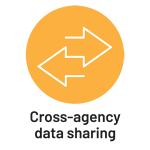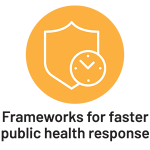having a solid foundation to stand on
a central platform for data sharing helps the ohio department of health move forward with speed and agility



promising practices
- Start with a meaningful use case or project to gain buy-in from program staff and leaders, and to work through data challenges such as security and legal issues.
- Build flexible platforms that can allow different tools; let program staff explore new platforms using their own tools.
- Talk to peers in other jurisdictions to get perspective and understand how others are solving data modernization challenges.
- Do not let perfection get in the way of progress.
In 2017, state leaders recognized the urgent issue of Ohio’s high infant mortality rate and wanted to see if data science and advanced analytics could shed light on the problem and potential interventions. This was the start of a meaningful project that accelerated the Ohio Department of Health’s (ODH) move toward data modernization and became the basis for the InnovateOhio Platform (IOP), a platform now used across state agencies in Ohio to share and analyze data.
Over a period of six months, 30 datasets from ODH, Department of Medicaid, Department of Job and Family Services, and the Department of Mental Health and Addiction Services were copied to the IOP for the project. By bringing these cross-agency data together, ODH found that fewer women at risk enrolled in Ohio’s Special Supplemental Nutrition Program for Women, Infants and Children (WIC) program than in other programs of similar eligibility, such as SNAP and Medicaid. Because WIC had been shown to be effective at keeping babies healthy, the team thought increasing enrollment in WIC might reduce infant mortality.
With this insight, they started another project which allows Ohio’s WIC program to automatically target people for enrollment who may be eligible based on enrollment in other programs. Fast forward a few years, and Ohio has seen impact—infant deaths in Ohio decreased from 7.2 per thousand live births in 2017 to 6.7 in 2020. While there’s potentially a number of contributing factors and still more work to do, the team believes WIC enrollment is playing an important role.
Jonathon George, Chief Data Officer at ODH, says IOP transformed the department’s approach to data. Because IOP data feeds are automated, the health department can create data products that are current and do not require a person to manually download a report out of a system, clean the data, connect to the clean data and then update the reporter dashboard. He says it takes an initial first step to load the data. “But once the data feed is automated, and updating on a regular basis, it can run from there. This helps to keep our [partners] and staff informed, and it opens opportunities to analyze data in a lot of new and exciting ways,” says George.
The use of IOP accelerated during the early days of the COVID-19 pandemic in 2020. ODH’s COVID-19 data team was faced with a barrage of questions and the need to get accurate information to leaders and the public quickly. It was a challenging time and the problem was exacerbated by the need to first figure out who the subject matter expert was with the data once a question was asked. The team gave individuals working on Ohio’s COVID-19 data response team access to the different databases. But doing so still required multiple logins and manual data quality processes to get the data in the format that was needed.
That changed when all the relevant COVID-19 data was placed on the IOP–providing the COVID data team with a single place to access all the relevant data and develop automated processes. Data transformation, data cleaning and data formatting could be automated. The data team created the initial dashboards and reports, and now those reports and dashboards are updated on a regular cadence.
George says the biggest impact that IOP had was getting information out to the public for COVID-19. “Looking back on how things were before IOP, I can’t imagine our being able to really automate and publish the amount of information we did without requiring a massive increase in resources.”
The use of IOP accelerated during the early days of the COVID-19 pandemic in 2020. ODH’s COVID-19 data team was faced with a barrage of questions and the need to get accurate information to leaders and the public quickly. It was a challenging time and the problem was exacerbated by the need to first figure out who the subject matter expert was with the data once a question was asked. The team gave individuals working on Ohio’s COVID-19 data response team access to the different databases. But doing so still required multiple logins and manual data quality processes to get the data in the format that was needed.
That changed when all the relevant COVID-19 data was placed on the IOP–providing the COVID data team with a single place to access all the relevant data and develop automated processes. Data transformation, data cleaning and data formatting could be automated. The data team created the initial dashboards and reports, and now those reports and dashboards are updated on a regular cadence.
George says the biggest impact that IOP had was getting information out to the public for COVID-19. “Looking back on how things were before IOP, I can’t imagine our being able to really automate and publish the amount of information we did without requiring a massive increase in resources.”
Key Takeaways
- An enterprise-wide data platform used across Ohio’s state agencies enabled advanced analytics and data sharing, offering potential solutions to complex public health issues.
- With insights from cross-agency data sharing, Ohio began increasing enrollment in its WIC program, which helped reduce the infant mortality rate in the state.
- Ohio’s central data platform has automated data transformation, cleaning and formatting, which facilitated getting information quickly to the public during the COVID-19 crisis.
- The platform’s frameworks can easily be adapted to different situations, which has proved crucial to Ohio’s swift response to mpox, measles and to a hepatitis outbreak in the state.
